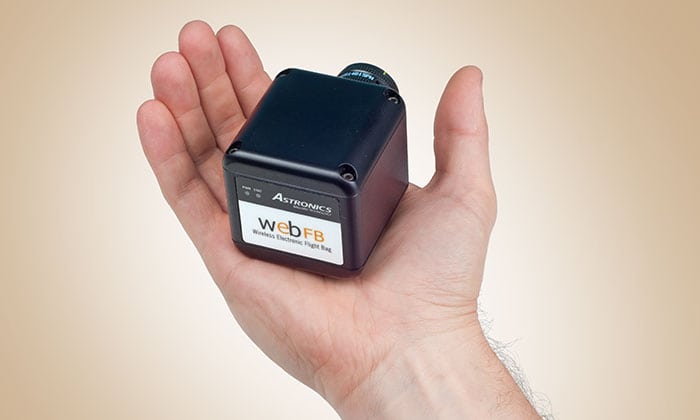[Avionics Today 08-01-2016] The FAA recently issued a Supplemental Type Certificate (STC) and Parts Manufacturing Approval (PMA) for the Astronics Corp. Wireless Electronic Flight Bag (WebFB) for use on the Boeing 737, marking the latest Aircraft Interface Device (AID) approval. WebFB provides another example of how new aircraft interfacing products are broadening the use of tablets in cockpits beyond replacements for paper-based charts by providing more access to aircraft data.

The Astronics webFB Aircraft Interface Device (AID) is small enough to fit into the palm of your hand. Photo: Astronics.
WebFB’s STC applies for the classic and next generation variants of the Boeing 737. As an AID installed directly into the flight deck, it uses a Wi-Fi Protected Access 2 (WPA2) 802.11 access protocol to externally connect portable tablet software and applications internally to ACARS and other avionics systems through an ARINC 429 channel. Flight Data Recorder (FDR) access is provided through an ARINC 717 channel and satcom is accessed through a serial channel.
Astronics Ballard Technology Vice President Jon Neal told Avionics Magazine the company discovered the need for a new type of AID for older aircraft while working with the Airlines Electronic Engineering Committee (AEEC) EFB subcommittee and users forum to develop the ARINC 759 standard. ARINC 759 provides AID design guidance for retrofit applications associated with older generation aircraft that primarily use ARINC 429 and 717 unidirectional buses.
“What we observed and learned through that process was that there’s no one size fits all AID for all the different airframes. For example, requirements for a narrow body aircraft will be different than for a wide body. A solution for a Boeing 737, especially in a retrofit context, needs a simpler device that is easier to install and provides an easy way to connect to the flight deck. This led us to the development of the webFB. It’s a remarkable device, in that it integrates an AID function, a small server and a wireless access point all into a cube that fits into the palm of your hand,” Neal said.
Astronics is not the only company evolving the capabilities of AIDs. In recent years, other companies have continued to release new AID hardware with new capabilities as well. United Airlines for example decided to equip its fleet of Airbus A320s with the UTC Aerospace Systems (UTAS) Tablet Interface Modules (TIM) and AIDs after UTAS received an STC from the FAA for its TIM and AID on the A320 and Boeing 737 in 2014. The difference is that with the UTAS products, EFBs get connected to the flight deck with a USB connected to the TIM, the TIM is then connected to the AID via Ethernet, and the AID connects to aircraft avionics using ARINC 717 and 429 channels.
Global Eagle Entertainment (GEE), through its 2015 acquisition of NavAero, similarly has a competing EFB systems communications module providing 802.11b/g/n and HSPD+/HSDPA/UMTS wireless connectivity to EFBs, and a Universal AID (UAID) that can act as a network switch and server with Network File Storage (NFS) capabilities. Similarly, Avionica has evolved its mini Quick Access Recorder (QAR) family of products to its avRDC platform, which combines miniQAR, Iridium satcom, flight deck server 3G/4G gateway and 802.11a/b/g/n wireless functionalities into a 14 oz. box. The avRDC was selected as factory standard equipment on the Gulfstream G650 at the 2015 NBAA conference and exhibition. Teledyne Controls’ GroundLink AID+, when coupled with the GroundLink Comm+, also has the ability to wirelessly connect EFBs to avionics systems through a backend ARINC 429 interface.
A differentiator for Astronics’ WebFB box, Neal says, is its size — 2.25 inches in height and width — ease of installation, and its ability to host EFB applications.
“It minimizes the aircraft downtime versus a more complex avionics bay installation,” said Neal, referring to webFB’s simple installation onto the existing test port or other locations within the aircraft flight deck.
“In addition to providing wireless data services, it can host a connected EFB application. Your traditional EFB applications, such as charts and maps, don’t require significant processing and run on the EFB. However, what we’re seeing is a next generation of EFB applications that require computation resources and may need some server capability. For example, with fuel efficiency applications you need to run the algorithms for fuel efficiency calculations; with quick access recorder apps, you need to process QAR data and provide notification of critical events,” said Neal.
Neal said Astronics is also currently working with software partners to develop a variety of enhanced EFB applications for the WebFB that are focused on increased operational efficiencies including fuel and time savings, electronic tech logs and real time QAR monitoring and event notifications.
Applications providers themselves also see the value in AIDs, according to manager of aviation business development for The Weather Company, Matthew Taylor. The Weather Company’s WSI Pilotbrief is the type of connected EFB application that can benefit from the use of an AID.
“The aircraft reports of turbulence and derived alert areas are used by pilots to quickly understand an impending turbulence area and take appropriate mitigations. As our EFB application evolves in the connected cockpit world, there are many parts that can be enhanced both directly and indirectly. Directly by automation of progress tracking and deviation monitoring. Indirectly through better advisement on contingencies when the data is further integrated into ground systems,” said Taylor.
According to Taylor, AID technology is dependent on having the right value proposition through the consuming applications it supports. EFB applications that can be enhanced by AID technology will continue to expand around increasing access to aircraft systems for operations support and extend back through the industry to aerospace manufacturers and software developers creating more informed systems for aircraft parts, MRO, fuel, and other aftermarket services, he says.
“An interesting example might be a construction company that can access the quality of braking action on runways as detected by aircraft and determine how to optimize their bid on re-grooving the surface,” said Taylor.